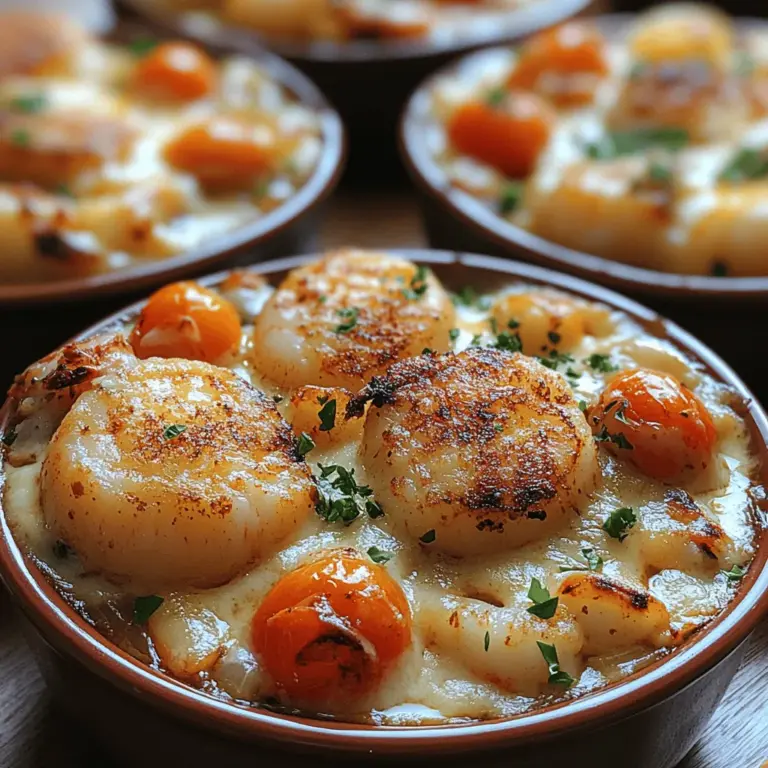Introduction
Seafood casseroles have long been a cherished dish across the globe, known for their ability to bring together a variety of flavors and textures in a single, comforting meal. The appeal of seafood casseroles lies not only in their taste but also in their versatility; they can be dressed up for a special occasion or kept simple for a weeknight dinner. Enter the Seafood Cassolette Delight—this dish elevates the traditional casserole into a luxurious yet approachable culinary experience.
The Seafood Cassolette Delight is a true testament to the incredible variety that seafood offers in cooking. From succulent shrimp and sweet scallops to earthy mussels and tender squid, each ingredient brings its unique characteristics to the dish. This recipe not only showcases these flavors but also highlights the health benefits of seafood, which is rich in omega-3 fatty acids, lean proteins, and essential nutrients. By incorporating these ingredients into a creamy, herb-infused sauce, the Seafood Cassolette Delight becomes a meal that’s both indulgent and nutritious.
Embarking on the journey to create this casserole is an exploration of flavors that combine the brininess of the sea with aromatic herbs and spices. The process of crafting this dish invites you to engage with the ingredients, learn about their origins, and appreciate the culinary techniques that enhance their natural qualities. Whether you’re a seasoned cook or a beginner looking to impress, this recipe promises to deliver a satisfying and delightful dining experience.
Understanding the Ingredients
To create the perfect Seafood Cassolette Delight, it’s essential to understand and appreciate the key seafood components that make this dish exceptional. Each ingredient plays a vital role in contributing to the overall flavor profile, and knowing how to select and prepare them will elevate your cooking.
Fresh Shrimp
Shrimp is often the star of many seafood dishes, and for good reason. Its tender texture and mild flavor make it incredibly versatile. Nutritionally, shrimp is a fantastic source of protein and is low in calories, making it a healthy choice for any meal. When selecting shrimp for your casserole, opt for fresh or sustainably sourced shrimp. Look for shrimp that are firm to the touch with a slight ocean scent, avoiding any that have a strong fishy smell.
Scallops
Scallops add a delicate sweetness to the Seafood Cassolette Delight that beautifully complements the other seafood elements. These bivalves are known for their tender, buttery texture, which can be easily overcooked, so it’s important to handle them with care. For the best results, sear the scallops briefly in a hot pan to achieve a golden crust while keeping the interior tender. When purchasing scallops, look for “dry” scallops that haven’t been treated with preservatives, ensuring the purest flavor experience.
Mussels
Mussels are not only delicious but also a sustainable seafood choice. They are farm-raised with minimal environmental impact and are packed with nutrients like iron, vitamin B12, and omega-3 fatty acids. When preparing mussels, freshness is key—look for tightly closed shells, which indicate liveliness. If any mussels are open, give them a gentle tap; if they don’t close, they should be discarded. When cooking, mussels will open during steaming, revealing their juicy meat inside.
Squid
Squid, or calamari, is another fantastic ingredient in our Seafood Cassolette Delight. Its unique texture and subtle flavor add depth to the dish. Fresh squid should have a mild, slightly sweet aroma, and its flesh should be firm and translucent. To prepare squid, it’s crucial to clean it properly; removing the beak, innards, and skin ensures a pleasant eating experience. For the best results, squid should be cooked quickly over high heat to prevent it from becoming tough.
Aromatics and Seasoning
No dish can achieve its full potential without the right aromatics and seasonings. In our Seafood Cassolette Delight, onion and garlic play a significant role in building the foundational flavors. Onions should be sautéed until they achieve a translucent quality, which indicates that their natural sweetness has been unlocked, while garlic should be added just before the other ingredients to prevent bitterness from overcooking.
In addition to these aromatics, smoked paprika and cayenne pepper provide a warm, smoky flavor with a hint of heat. These spices enhance the dish’s complexity and can be adjusted to suit your palate. The cream and fish stock create a rich, velvety sauce that binds all the flavors together, making each bite a delightful experience. Lastly, fresh herbs, like parsley, are essential for garnish, adding a pop of color and a fresh finish to the casserole.
Preparation Steps Explained
Now that you have a comprehensive understanding of the ingredients, it’s time to dive into the preparation steps for the Seafood Cassolette Delight. Each step is designed to enhance the flavors and textures of the dish, ensuring that the final product is nothing short of spectacular.
Preheating the Oven
Before you begin assembling your casserole, preheating the oven is crucial. The ideal baking temperature for casseroles typically ranges between 350°F to 375°F (175°C to 190°C). Preheating ensures that your dish cooks evenly and thoroughly, allowing the flavors to meld beautifully without drying out any of the seafood. A hot oven will also help achieve a nice golden crust on top, which adds a satisfying texture to the final presentation.
Sautéing Aromatics
The first step in bringing your Seafood Cassolette Delight to life is sautéing the aromatics. Begin by heating a generous amount of olive oil or butter in a large skillet over medium heat. Once hot, add the chopped onions, allowing them to cook slowly until they reach a translucent state. This process typically takes about 5-7 minutes. The goal is to soften the onions without browning them, as their sweetness is pivotal in forming the base of your dish.
After the onions have softened, add minced garlic to the pan. Garlic should be sautéed just until fragrant—usually about 30 seconds to a minute. This timing is critical; overcooked garlic can turn bitter and overpower the dish. Stir constantly to ensure even cooking and to prevent sticking.
Tips for Achieving the Perfect Translucency in Onions
To achieve the perfect translucent quality in your onions, consider the following tips:
– Use a Wide Pan: A larger surface area allows for more even cooking and moisture evaporation.
– Keep the Heat Moderate: Cooking onions over too high of heat can cause them to brown rather than soften.
– Stir Frequently: Regular stirring promotes even cooking and prevents burning.
By following these tips, you will unlock the natural sweetness of the onions, setting the stage for a flavorful casserole.
Importance of Garlic Timing
As previously mentioned, timing is everything when it comes to adding garlic. To avoid bitterness in your dish, here are a few key points to keep in mind:
– Add Garlic Last: Always add garlic after the onions have softened to prevent it from cooking too long.
– Monitor the Aroma: Once you smell the aroma of garlic, it’s time to move on to the next step; don’t let it linger in the pan for too long.
– Use Fresh Garlic: Fresh garlic has a more vibrant flavor than pre-minced or dried options, enhancing the overall taste of your casserole.
With these initial steps in mind, you are well on your way to creating a stunning Seafood Cassolette Delight that will impress your family and friends. The careful preparation and attention to detail will ensure that each bite is bursting with flavor, making it a memorable dish for any occasion.
{{image_1}}
Cooking Seafood: Best Practices for Not Overcooking
When preparing seafood for your Seafood Cassolette Delight, it is crucial to master the art of cooking without overdoing it. Overcooked seafood can become tough and rubbery, detracting from the overall experience. Here are some best practices to ensure your seafood remains tender and flavorful:
1. Timing is Key: Different types of seafood require different cooking times. For instance, shrimp takes only about 3-5 minutes to cook through, while fish fillets may need slightly longer, around 4-6 minutes depending on thickness. Always keep a close eye on your seafood as it cooks.
2. Use a Thermometer: For precision, consider using an instant-read thermometer. Most fish should reach an internal temperature of 145°F (63°C), while shellfish like shrimp and scallops should turn opaque and firm to the touch.
3. Sear First: If you like a crispy exterior, sear your seafood briefly in a hot pan before adding it to the cassolette. This technique locks in moisture and adds an additional layer of flavor.
Tips on Recognizing Doneness for Different Types of Seafood
Being able to recognize when seafood is perfectly cooked is essential for achieving the best results in your dish. Here are some tips for various seafood types:
– Shrimp: Cook until they turn pink and opaque. If they curl tightly into a C shape, they are likely overcooked.
– Fish: Look for flakes that separate easily with a fork. The flesh should be opaque and no longer translucent.
– Scallops: Ideal scallops should be golden brown on the outside and opaque in the center, tender yet firm.
Incorporating Vegetables and Cream: Balancing Flavors
In your Seafood Cassolette Delight, the incorporation of vegetables and cream is not just about adding texture but also about balancing flavors. Fresh vegetables like bell peppers, leeks, and zucchini add crunch and sweetness, while a splash of cream enriches the dish without overpowering it.
– Cherry Tomatoes: These juicy morsels play a critical role in your cassolette. Their acidity brightens the dish, cutting through the richness of the cream and cheese. When cooked, they burst slightly, contributing both sweetness and a beautiful color contrast.
Discussing the Simmering Process for Flavor Melding
Once your seafood and vegetables are cooked, the simmering process is where the magic happens. This step allows the ingredients to meld together, creating a harmonious flavor profile. Here’s how to do it right:
1. Add Broth or Stock: After sautéing your seafood and vegetables, add a splash of seafood stock or white wine to deglaze the pan. This not only enhances the flavors but also captures any bits stuck to the pan.
2. Simmer Gently: Allow the mixture to simmer on low heat for about 10 minutes. This gentle cooking will help infuse the seafood with the flavors of the vegetables and any herbs you’ve added, enhancing the overall taste of your cassolette.
Assembling the Cassolette
Now that your seafood and vegetables are perfectly prepared, it’s time to assemble your cassolette.
Choosing the Right Cassolette Dishes: Material and Size Considerations
Choosing the right vessel for your Seafood Cassolette Delight is essential for both cooking and presentation. Traditionally, individual ceramic cassolette dishes are preferred, as they retain heat well and create an appealing rustic look.
– Material: Opt for ceramic or cast iron for even heating. These materials help achieve that desired bubbly, golden top.
– Size: Individual servings are ideal for entertaining, but you can also use a larger baking dish for family-style servings. Just ensure that the dish is deep enough to accommodate the layers of seafood and sauce.
Layering the Seafood Mixture with Cheese: Tips for Even Distribution
To ensure that every bite of your cassolette is packed with flavor, proper layering is key. Here are some tips:
1. Start with Vegetables: Begin by spooning a layer of your vegetable mixture into the bottom of the cassolette dish.
2. Add Seafood: Gently place your seafood mixture on top of the vegetables, distributing it evenly.
3. Finish with Cheese: Generously sprinkle grated Gruyère cheese over the top. This cheese melts beautifully and forms a delicious crust.
Importance of Cheese Selection: Why Gruyère Works Well
The choice of cheese can make or break your dish. Gruyère is an excellent option for Seafood Cassolette Delight due to its nutty flavor and exceptional melting qualities. As it bakes, Gruyère creates a golden, bubbly crust that adds both texture and richness to the cassolette. If you prefer a sharper flavor, consider mixing Gruyère with a bit of aged cheddar for complexity.
Baking to Perfection
Temperature and Timing: Ensuring a Bubbly, Golden Finish
To achieve the perfect Seafood Cassolette Delight, preheat your oven to 375°F (190°C). Bake your assembled cassolette for approximately 25-30 minutes, or until the cheese is bubbling and golden brown. Here’s how to ensure success:
– Even Baking: Place the cassolette dish in the center of the oven to ensure even heat distribution.
– Broil for Extra Crispiness: For a more pronounced crust, switch to broil for the last 2-3 minutes of baking, keeping a close eye to prevent burning.
Signs That the Cassolette is Ready to Be Taken Out of the Oven
Knowing when your cassolette is ready can be challenging. Look for these signs:
1. Bubbling Cheese: The cheese should be bubbling vigorously around the edges.
2. Golden Brown Top: A light golden crust indicates that it is time to remove the cassolette from the oven.
3. Aroma: The delightful scent of melted cheese and seafood should fill your kitchen, beckoning everyone to the table.
Serving Suggestions
Presentation Tips for an Elegant Dining Experience
Presentation plays a vital role in enhancing the dining experience. Here are some tips for serving your Seafood Cassolette Delight:
– Garnish: Fresh herbs such as parsley or chives can add a pop of color and freshness on top of the cassolette.
– Serve Hot: Present the cassolette dishes straight from the oven, allowing guests to enjoy the warmth and aroma.
Ideal Pairings: Suggested Side Dishes or Wines That Complement the Seafood Cassolette Delight
For a well-rounded meal, consider these pairings:
– Side Dishes: A light green salad with a vinaigrette or steamed asparagus can balance the richness of the cassolette.
– Wine Pairings: A crisp Sauvignon Blanc or a light Pinot Grigio pairs beautifully with the seafood, enhancing its flavors without overwhelming the palate.
Discussing the Versatility of the Dish for Various Occasions
The Seafood Cassolette Delight is perfect for various occasions, whether it’s a cozy family dinner or an elegant dinner party. Its versatility allows for customization based on seasonal ingredients or available seafood, making it a dish that can be enjoyed year-round.
Nutritional Information
Breakdown of Nutritional Benefits of the Dish
Seafood Cassolette Delight is not just delicious; it also offers numerous health benefits:
– Protein-Rich: Seafood is an excellent source of high-quality protein, vital for muscle repair and growth.
– Omega-3 Fatty Acids: Fish and shellfish are rich in omega-3 fatty acids, which are essential for heart health.
– Vitamins and Minerals: The dish is packed with vitamins such as B12, vitamin D, and minerals like selenium and zinc, contributing to overall health.
Discussing Portion Sizes and How It Fits into a Balanced Diet
While Seafood Cassolette Delight is nutritious, portion control is key. A serving size that includes a modest amount of seafood and a generous serving of vegetables can fit well into a balanced diet. Pair it with whole grains or a side salad to create a complete meal.
Conclusion
Seafood Cassolette Delight stands out as a must-try dish for seafood lovers, featuring a delightful combination of tender seafood, fresh vegetables, and creamy cheese. The joy of cooking and sharing this recipe with friends and family makes it even more special.
Embrace the opportunity to explore variations based on personal preferences or seasonal ingredients, allowing you to make this dish your own. Whether it’s a comforting weeknight dinner or an impressive centerpiece for a gathering, this cassolette is bound to impress. So gather your ingredients, follow the steps, and indulge in the delightful flavors of your Seafood Cassolette Delight today.


